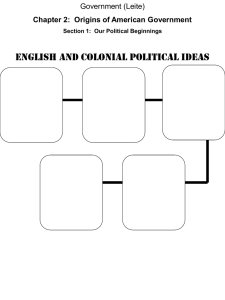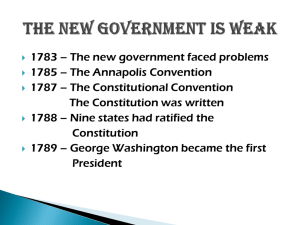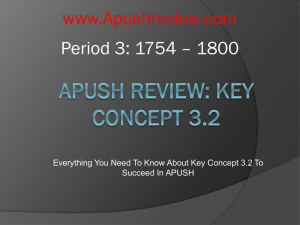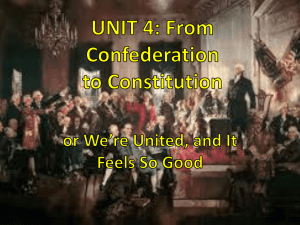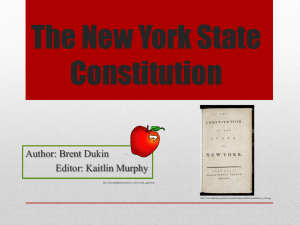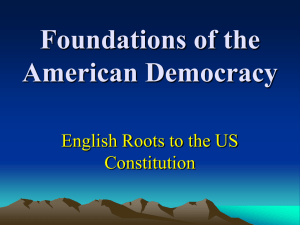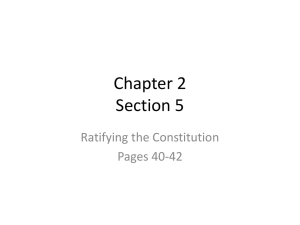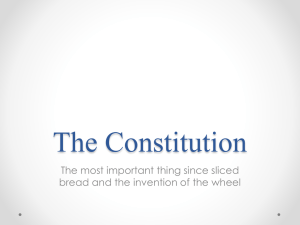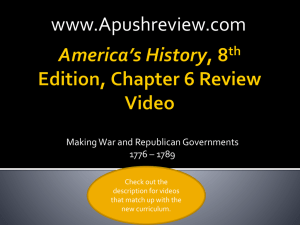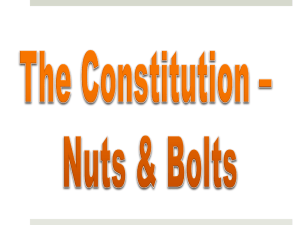confederation to constitution
advertisement
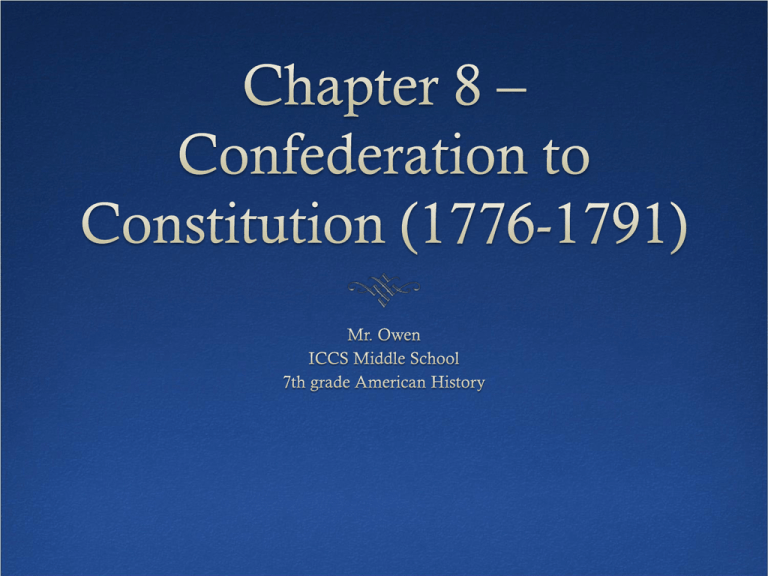
After the War The 13 colonies are now free of British rule and are a new country called The United States of America The Americans control all of the land from the Atlantic to the Mississippi and from the Gulf of Mexico and to the Great Lakes British still control Canada and Spanish are west of Mississippi Defining a Country Following the American Revolution, the newly established United States of America faced the challenge of defining itself as a new country. At first, the Americans are worried about a strong central government for the nation, leading to a weak, ineffective one under the Articles of Confederation The US Constitution creates a stronger central government to replace the failed Confederation This new Constitution protects many American rights and liberties with the Bill of Rights Section 1 – The Confederation Era Vocabulary Confederation Congress – national legislative body created by the Articles of Confederation Articles of Confederation – plan for national government in the US ratified in 1781 Northwest Territory – lands northwest of the Appalachian Mountains Northwest Ordinance – law that described how the NW Territory would be governed Background Republic – state, country or nation in which people elect representatives to govern them Ratification – an act of official conformation Neutral – not siding with one country or another Framing a Government The new Americans wanted to fix some of the things they thought were wrong with Britain, so their new government: Was a republic that allowed people to vote on representatives (but not everyone could vote) Had strong state constitution that outlined people’s rights and defined the states powers Had a weak national (or central) government This government was formed under the Articles of Confederation Homework Read hand out about Articles of Confederation and be prepared for a short quiz about the information Quiz 1. What was the first government created by the Americans called? 2. What was the name of the document that said how this government would work? 3. True or false: The first government appointed a king for the US. 4. True or false: This government had strong state governments and a weak national government 5. Name one power of this national government 6. Name two weaknesses of this government Powers of Confederation Congress Allowed by Congress Denied to Congress Conduct foreign affairs Establish executive branch (president) Declare war and make peace Enforce national laws Enact or collect taxes Control Western lands and Indian affairs Regulate trade between states or other countries Establish Federal courts Run postal service Amend Articles Issue or borrow money Why might the national government been weak because of the powers it was denied? Strengths and Weaknesses with the Articles of Confederation The Land Ordinance of 1785 establishes how new territories and states are created No slavery, rivers are free, freedom or religion and trial by jury Limited national government’s ability to deal with foreign countries Spain and Britain refuse to allow American trade in the Caribbean and around Great Lakes Inability to levy taxes keeps national government poor Can’t pay debts from war (soldiers) States have to raise their own taxes which makes people mad Homework Yellow words for section 2 on page 242 in notes or on note cards Read “The Northwest Territory” on page 240-241 and answer the 3 questions on page 241 “Connect Geography and History” Section 2 – Creating a Constitution Vocabulary Checks and balances – system in which each branch of government checks the power of the other branches Executive branch – part of government that enforces laws and leads country Legislative branch – part of government that makes laws Judicial branch – part of government that interprets laws Government Constitutional Convention – 1787 meeting that created the US Constitution Virginia Plan – proposal for legislature based on population or wealth New Jersey Plan – proposal for legislature in which each state got 1 vote Great Compromise – agreement that establishes 2 house legislature with 1 house having equal representation and 1 with representation based on population Three-fifths Compromise – agreement that slaves would count as 3/5ths of a person for representation and taxation People Founders – people who helped create the US Constitution James Madison – important advisor to the Constitutional Convention Calling for a Convention What: a group meeting to discuss changes that the national government needed Who: the Founding Fathers (Madison, Hamilton, Washington and others) When: starting on May 25, 1787 Where: Philadelphia PA Why: they recognized the Articles of Confederation were not strong enough and the US might fail How: Each state sent representatives to the convention including many famous men of the time John Adams Samuel Adams Ben Franklin John Hancock • James Madison Challenges at the Convention There were many things to discuss at the convention and many delegates were still worried about creating a national government that was too strong Two issues they had to agree on were: Representation and Slavery Representation in Government Virginia Plan New Jersey Plan Favored states with large populations Favored states with small populations Two houses with the number of votes based on the population of the state One house with one vote per state regardless of population • Both plans created an executive and judicial branch and proposed system of checks and balances to keep one branch form getting too much power • Eventually, The Great Compromise solves the conflict by creating two houses in the legislature, one with equal votes and one with representation based on population Questions about Slavery What: deciding who “counted” in a states population Who: African-American slaves When: during the Constitutional Convention Where: debate between the Northern and Southern delegates How: Southern states wanted slaves counted so they had larger populations while Northern states did not Why: The delegates agree on the Three-Fifths Compromise which counted 3/5ths of a state’s slaves in the population for representation and taxation. The Compromise also protected slavery in the South Slave population in 1790 Powers of State and National Government Homework Yellow word vocabulary for chapter 8 section 3 on page 248 Section assessment questions for section 2 on page 247 #s 4, 5 & 6 Quiz on the first 10 amendments (the Bill of Rights) next week See handout – we will be talking about them next week but start to work on memorizing them now Section 3 – Ratification and the Bill of Rights Vocabulary Federalism – system of government in which power is shared between the national government and the states Federalists – people who supported the Constitution Anti-federalists – people who opposed the Constitution The Federalists Papers – essays published in newspapers about the Constitution Amendment – an addition to a document Bill of Rights – the first ten amendments to the Constitution Majority rule – system in which of more than half the group agrees, the decision binds the whole group Arguments Over Ratification After the Constitution was written, two different groups emerged; those that were for the Constitution and those against it. The most important difference was what role the national government would play and how it related to state government Those in favor of the Constitution and national (or federal) government were called Federalists Those against it were called Anti-federalists Concerns of the Federalists and Anti-federalists Federalists Anti-federalists Federalism is a system of government in which the national and state governments share power Thought the Constitution took too much power from the states Also, the 3 branches and checks and balances would keep things equal Supported by rural areas and large population states Federalists James Madison, Alexander Hamilton and John Jay wrote essays called The Federalists Papers to support their cause Patrick Henry, Samuel Adams and James Monroe were important Antifederalists Protecting People’s Rights The Anti-federalists wanted a list of rights that were guaranteed to be protected and that the national government could not take away They wanted a Bill of Rights Eventually, the Federalists agree to this demand and the Bill of Rights is added at the end of the Constitution making the first 10 amendments to it The Bill of Rights 1. Religious and political freedom 2. Right to bear arms 3. No Quartering troops 4. No illegal search and seizure 5. Rights of accused people 6. Right to speedy, public trial 7. Right to jury trial 8. Limits fines and punishment 9. Rights of people 10. Powers of states and people Ratification The Constitution still needed to be ratified and had to be approved by 9 of the 13 states according to the Articles of Confederation Nine states approve it between December 1787 and June 1788 However, Virginia, New York and North Carolina do not and many are worried that is will fail without the large states support Ratification continued Both Virginia and New York eventually ratify it after the states agree to adding a Bill of Rights North Carolina does not ratify it until AFTER George Washington is sworn in as the first president Improvements to the US Government (pg. 253) Confederation Weakness Constitution Strength National government could not collect taxes Could collect taxes Could not regulate trade Allowed to regulate trade No national courts Established national court No president Established president One state, one vote (no population Proportional representation Laws approved by 3/4th of states Simple majority needed Amendments must be unanimous Only 2/3rds needed Homework Section assessment questions on page 254 #s 3, 4, 6 & 7 Review Day – 7-1 Thursday 17th 7-2 Friday 18th Test Day – Tuesday 22nd Review Democracy – government of the people, everyone gets to vote on laws Republic – a bunch of smaller groups together forming one big government, elect representatives to vote on laws
